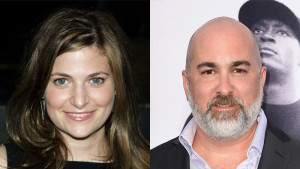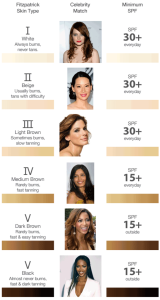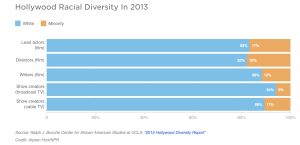Hollywood: A Poor Representation of America and its Diversity
By Alana O’Neill
To say all races were created equally would be a true statement. However, to say that all races are treated equally would be inaccurate. Throughout American history, it is prevalent that as time goes on, racism has become relatively less severe. This is not, however, to be confused with the assumption that racism no longer  exists. It is seen in more subtle forms that can easily be swept under the rug with a bit of smooth talking and playing innocent. Yes, there is no longer the obvious blackface in films anymore, in which white actors would paint their faces black to play people of color. But there are subtle forms of racism that are still alive today, with connotations that seem to mimic aspects of blackface. Blackface was originally used so that people could avoid working with people of color as well as a way to mock harsh stereotypes in a condescending manner. Modern day there is whitewashing. Rather than changing the actor to fit the character, now people change the character to fit the actor.
exists. It is seen in more subtle forms that can easily be swept under the rug with a bit of smooth talking and playing innocent. Yes, there is no longer the obvious blackface in films anymore, in which white actors would paint their faces black to play people of color. But there are subtle forms of racism that are still alive today, with connotations that seem to mimic aspects of blackface. Blackface was originally used so that people could avoid working with people of color as well as a way to mock harsh stereotypes in a condescending manner. Modern day there is whitewashing. Rather than changing the actor to fit the character, now people change the character to fit the actor.
Of course, manipulating the character is just one example of whitewashing. People can be whitewashed on the set and behind the cameras. People of color get less recognition for their accomplishments in the film industry than their white counterparts, as perfectly exampled in the 88th Academy Awards.
The Daily Show points out that the only recognition the movie Straight Outta Compton received were two Oscar nominations for their writers. Both of these writers are white. Mind you, this is a movie based on real life events starring black people, about NWA a  black gangsta rap group and the adversity they’ve face and their struggle to get to the top. I am not arguing that the writers are undeserving of their nomination, I do think, however, the movie deserved more nominations than just the two for the two white writers.
black gangsta rap group and the adversity they’ve face and their struggle to get to the top. I am not arguing that the writers are undeserving of their nomination, I do think, however, the movie deserved more nominations than just the two for the two white writers.
Personally, I was appalled that this movie was not nominated of an Oscar. I saw Straight Outta Compton when it came out in theaters and not only did the movie make me laugh and cry, but I also had a great time jamming out to the music. Their story moved me and was inspiring, making it insulting that the movie did not receive the recognition I, and many others, believe it deserved. The Oscars did a great job in highlighting the lack of recognition and acknowledgements for black actors, directors, and writers, however they did a poor job in honoring their theme: The lack of diversity in Hollywood.
All people of color can be, and have been whitewashed in the film industry. Sometimes it is subtle and sly, like in The Hunger Games, and sometimes is it far more obvious, Like in Aloha and Gods Of Egypt.
I have read the first Hunger Games book and did not even pick up on the subtle whitewashing at first. I only noticed it existed after doing some research on it. The book describes the protagonist lead role, Katniss Everdeen, as “olive skin, dark hair, and grey eyes.” I then  looked up what olive skin tone was, and technically it falls between a four and five on the Fitzpatrick scale (which measures how different skin tones react with ultra-violet light). A four on the scale is described as a person who is, “minimally sun sensitive, burns minimally, and always tans to moderate brown.” With examples being, “Mediterranean type Caucasians and some Hispanics.” A five on the scale can be described as a person who has, “sun insensitive skin, rarely burns, and tans well” while examples being, “some Hispanics and some blacks.”
looked up what olive skin tone was, and technically it falls between a four and five on the Fitzpatrick scale (which measures how different skin tones react with ultra-violet light). A four on the scale is described as a person who is, “minimally sun sensitive, burns minimally, and always tans to moderate brown.” With examples being, “Mediterranean type Caucasians and some Hispanics.” A five on the scale can be described as a person who has, “sun insensitive skin, rarely burns, and tans well” while examples being, “some Hispanics and some blacks.”
Regardless of a person’s interpretation of what “olive skin” is, it is evident that Katniss is racially ambiguous. The whitewashing occurred, however, behind the scenes during the casting call. The director, Gary Ross, called for “…Caucasian, between ages 15 and 20…”
This completely closed the door on any actress of color from even being considered. The controversial topic arose of whether Jennifer Lawrence should have been casted and if she’s even deserving of the part. The lack of the opportunity for diversity has nothing to do with Jennifer Lawrence and it is important that people understand this. She very well could have still been picked to play Everdeen even with a casting call including minorities and darker skinned women. This is about how the book opened the door for a minority actress to be in a strong female role and the door was abruptly closed before even giving anyone a chance.
Many young women were excited to finally have a person of color as the strong lead female role in a movie where the character is pretty hardcore. With the lack of this type of attention towards people of color in a leading role, it becomes easy to understand why this book was somewhat a sigh of relief for the young women of color; the book made them hopeful.
The popularity of the series would have been a great opportunity to promote a minority for the lead role. Whether motives for the unfair casting call were driven by money or by favoritism (or both), people of color clearly were not given an equal chance. A beautiful opportunity was presented to go against Hollywood norms and give the role of a very popular series to a woman of color, and the fact that this was not even considered screams that there is a problem within the industry.
I also took the time to watch Aloha to see some whitewashing firsthand. I’ve first heard of the movie because of the negative comments it has received about the director’s casting decisions. I found it very odd to see Emma Stone (a white actress with blonde hair and light eyes) play a mixed character. In the movie, she even talks about her racial background, which was another red flag to me. The director knew the character was part Hawaiian and part Asian and doesn’t even manipulate the plot in order to cast this white actress. He rubs it in the audiences’ faces (at least that’s how I felt) that the character is mixed but that he doesn’t give a care in the world to cast a mixed actress. At least in some instances of whitewashing, which I will touch on later, the director manipulates the tone of the film to make it more white and Eurocentric, thereby “justifying” the direction to cast a white actor where he/she may not belong. In the movie, Allison Ng says that her father is half Hawaiian and half Asian while her mother is of Swedish decent. Apparently in director Cameron Crowe’s eyes, being half white is enough of a reason to cast a fully white actress. Being half white makes it okay to ignore the colored half of the character.
the audiences’ faces (at least that’s how I felt) that the character is mixed but that he doesn’t give a care in the world to cast a mixed actress. At least in some instances of whitewashing, which I will touch on later, the director manipulates the tone of the film to make it more white and Eurocentric, thereby “justifying” the direction to cast a white actor where he/she may not belong. In the movie, Allison Ng says that her father is half Hawaiian and half Asian while her mother is of Swedish decent. Apparently in director Cameron Crowe’s eyes, being half white is enough of a reason to cast a fully white actress. Being half white makes it okay to ignore the colored half of the character.
Another form of whitewashing involves a different type of manipulation. Sometimes directors alter the plot or the character to make the movie fit more of that white, Eurocentric template. An example of this is the movie Lincoln. This movie is highly disputed because the whitewashing is much less evident than in any of the other examples. Some people feel that the director, Steven Spielberg, didn’t accurately capture the essence of the real-life event.
Lincoln is a movie about the emancipation of the slaves in America. History shows that freedom for people of color was a collaborative effort between free and enslaved black people along with white people. The movie seems to portray the white characters as too much of a “hero” type role; as if black people were helpless and were waiting for the heroic white men to swoop in and save them. The movie does not seem to honor the hard work from BOTH races to make America free for all, which is where the controversy lies. Corey Robin, a political theorist, journalist, and professor, sums it up perfectly. He states, “Emancipation was not a white man’s affair. It was a multiracial affair, in which blacks, slave and free, played a central role. Spielberg and Kushner are not being faithful to the historical record; they are distorting it. Not by lying but by constructing the field glasses through which they would have us look at, and misperceive, the past.”
This is a very subtle form of whitewashing being that the movie, in a sense, is tailoring to the white folk. I, along with many others, am not saying white people did not play a huge role in the emancipation of slaves, I am saying that they were not the ONLY people to play a huge role.
It is very clear that whitewashing exists in Hollywood, but why? Some people claim that this issue is not race driven, but money driven. Directors feel obligated to hire the big name white actors in order to generate the most profit on their films.

Tailoring to the white majority seems to be the route many directors and writers take, because if the majority of the people are watching, the more money the film will make. While this makes sense, it also saddens me because this seems like a difficult rut for the film industry and film viewers to escape from. There is a huge lack of representation of minority groups because there is much more money in representing the white majority. It makes it difficult for me to imagine, at least in the near future, Hollywood providing equal opportunity for all races. I understand that movies are a lot of work and directors may be put in a tough situation on whether to stay morally accurate to the races of the characters or to reward all the hard work of everyone involved with the movie by doing his/her best to make as much money as possible and get the movie as much recognition as possible.
This is where the public comes into play. The issue of whitewashing in Hollywood does not solely put the blame on the film industry; viewers have a stake in this issue as well. Hollywood seems to be money driven, so to change the lack of diversity, the majority of viewers have to pay more attention to race representation and unjust actions by filmmakers.
If the majority makes it clear they will not accept whitewashing in Hollywood, I believe Hollywood will stop whitewashing.
Reflection:
WRT 205/Spring 2016 Grading Rubric: Unit III NYTs Magazine
[1] I think the title encompasses everything I talk about in the article. It starts with Hollywood, which represents the film industry, and goes on to mention how Hollywood’s vision is so skewed about the diversity America encompasses. And Hollywood is so popular and so well known by everyone that it’s shocking that there is such an issue that continues to happen in modern day film.
[2] I think my introductory section tends to meander a little. That was the part I struggled with the most. I talk about the issue and give historical background about how racism in the film and theater industry evolved as well as the connotations behind such actions, like when I mentioned blackface. However, I don’t specifically mention Hollywood, but my thought process was that the title took care of that, since it clearly states that I will be talking about Hollywood. I think I could have had a stronger element to invite the reader in. I think it offers up exigency because I state that whitewashing exists modern day.
[3] I think I offer up a strong idea well because I explicitly state that whitewashing is racist, without a doubt in the reader’s mind that I think otherwise. However, most people don’t see it as racism. I then immediately go into examples that explain in further detail why whitewashing is racist. When I had peers review my writing during unit II, the most frequent comment I got was that people had no idea whitewashing was actually going on, it its very clear once it was pointed out. I pulled examples from the 88th Academy Awards, Straight Outta Compton, The Hunger Games, Lincoln, and Aloha. All of these examples are current, which also shows that this is an issue that not only has bee occurring since film and theater started, but still occurs today.
[4] I struggled a bit with style at first because usually I tend to have a very formal writing style, but I tried to sound like I was talking when I was writing. As if it would sound natural like if I were speaking to a peer through my writing. I think I was unique in the piece because I incorporated a lot of first-hand examples from watching the movies Aloha and Straight Outta Compton and reading the Hunger Games and watching the Oscars. Having these examples allowed me to express how I felt from seeing these first-hand and I clearly stated, like in the Straight Outta Compton paragraph, how each piece influenced me. I was also able to share how my opinions, feelings and experiences, mimicked or differed from that of other people. I also pulled from history when I talked about blackface and the movie Lincoln.
[5] I think I recognized that well and did a good job to avoid being vague. I went into depth explaining how each example showed racism, even the ones that were very subtle and hard to detect. I also think that many people aren’t fully aware about how many racist connotations exist in modern day Hollywood, so many of the points I made are new thought and make it difficult to challenge without extensive knowledge of the subject. Also during my research, I looked up both sides of argument and formulated a counter argument to null the one that justifies whitewashing. For example, a reason that many people say whitewashing isn’t racist is because it directly has to do with money, rather than favoritism. I countered this by talking about how that proves that this still has to do with racism because the amount of money that a film makes should have nothing to do with the race of the actor. The movie should honor the true race of the characters without having to feel like they are putting their profit in jeopardy.
[6] I researched well and understood arguments from both sides of the argument that way it allowed me to strengthen my argument better. By understanding both, it allowed me to come up with ways to disprove the counter argument. I incorporated a lot of research as well as a lot of primary sources, being that they were very easy to acquire. I then added my own opinion to these sources I’ve read. I have also learned a lot about subtle racism throughout the whole process which I didn’t know existed which, I believe aided in having a tone in my argument because I was appalled to learn that all of this was still going on modern day. From what I learned about whitewashing, I was able to notice the subtle racism and oddness when I watched Aloha that I know I would not have noticed before the research. I explain in the article that I found it very odd that a white woman was playing a character and the character explicitly explains her racial background of being mixed when the person playing her is not mixed at all.
[7] I definitely exceed the requirements for research because all of unit two I used secondary resources to formulate my argument so all of my initial ideas came from that ( and there were about 7 secondary sources I used for that) and obtaining primary resource was very easy for me and I have actually had primary knowledge before even starting the assignment. I saw Straight Outta Compton when it came out in 2015 and read the first Hunger Games book in High School. After the assignment I also watched Aloha. I also incorporated a lot of visuals in the piece, being that this topic seemed like it was a necessity to have pictures. The “olive skin” portion definitely needed a visual to show what the technical color “olive skin” looks like according to the established Fitzpatrick scale.
[8] I think I integrated the sources well being that it seems like I incorporate them seamlessly. The first source I use is in the introductory paragraph where I talk about blackface and what that was used for in early film and theater then for the rest of the piece I incorporate ideas a formulated myself through primary research as well as the ideas I researched on line. I also talk about how the online ideas influenced my thinking process. I think it complicated the analysis because it shows how racist Hollywood can be even though people claim it is just driven by money.
[9] I think I do a decent job in building my research because nothing I have talked about lacked support from many other people I have researched. Ethos: I believe I sound credible being that I use a lot of first hand experiences backed up with the experiences and words of experts. Logos: I believe that my piece makes sense being that it is very easy to see whitewashing by simply looking at pictures. And I think that the whitewashing that is subtler, I do a decent job of explaining, like the Hunger Games example. Pathos: I tried to evoke emotion for the reader through my writing, I think I sounded very passionate while doing so. I was debating on whether I should explain how I am a minority and how that could make me seem more passionate about the injustice that is occurring in Hollywood but I opted out because I actually believed that would be counter effective. Many minorities represent their own racial group already and there is still little to no change. Plus, I am writing a piece that shows how Hollywood is corrupt, so no matter who says it, it is true that Hollywood whitewashes. It doesn’t matter my race, the point is not what race is speaking about what race. The point is that a person is speaking about the issue.
[10] Yes, I believe I use appropriate visuals because, especially with my topic, visuals are important in allowing the reader to fully understand. I describe the type of character in a movie, and then show the actor playing that part. I feel like I needed a visual in the paragraph about Aloha because people may not know who Emma stone is. One of the best visuals in the piece is the Fitzpatrick scale because it actually gives examples of celebrities who have an olive skin tone. Even though olive skin is ambiguous, if the director were staying true to the context of the book, he would’ve at least considered an actress that looks like the ones I pictured. I also put a visual at the end that I think ties everything together. It’s a chart that shows the distribution of whites and minorities is the film industry both in front of, and behind the camera.
[11] I showed development because in my first couple drafts my introductory paragraph was much worse, I had the ideas all there but I placed it terribly and didn’t do a good job explaining how whitewashing has similar connotations to blackface. It kind of felt forced in the piece in my original draft and it lacked proper flow. I also realized from the paragraph scrambling that all the paragraphs that I talk about different examples could easily be interchanged. So for the final piece I went back in and tried to tie the end of one paragraph to the beginning of the next one. For example, I mention in the paragraph about Aloha that there are times in which the director manipulates the plot of the character to justify their actions to picking the actor or telling a story a certain way, then I immediately talk about Lincoln in which Spielberg does just that.
[12] Yes they are effective and appropriate because I use them to show that something I am talking about can go into further detail. However, explaining this detail myself wouldn’t fit into my article being that it would sound too much like a tangent or it strayed from my initial topic too much. I think the information is appropriate and those who want to know more about the topic in depth have to option to click the hyperlink.
[13] I proofread and believe I didn’t make any grammar or spelling errors. I have a tendency to make run-on sentences as well so I went back are tried to edit those as well. I am happy with the final product and think all my sentences are an appropriate length.

